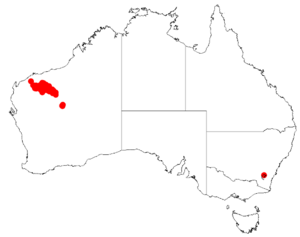Karijini wattle facts for kids
Quick facts for kids Karijini wattle |
|
|---|---|
| Scientific classification | |
| Genus: |
Acacia
|
| Species: |
hamersleyensis
|
 |
|
| Occurrence data from AVH | |
The Karijini wattle (also called Acacia hamersleyensis or Hamersley Range wattle) is a special type of tree or shrub. It's part of the Acacia family, which includes many different wattle plants. This plant only grows in a small part of central Western Australia.
What Does the Karijini Wattle Look Like?
This tree or shrub usually grows to be about 1.5 to 5 meters (5 to 16 feet) tall. It can look spindly and spread out, or it can be bushy and rounded. Sometimes, it has up to six main stems growing from the ground. Older plants might look twisted and have a thin canopy of leaves.
The bark on the main stems is dark brown, grey, or black. It has long cracks and feels rough. Higher up on the branches, the bark is smoother. The younger branches are yellowish to light brown. They might even have a pale, powdery coating.
Like most Acacia species, the Karijini wattle doesn't have true leaves. Instead, it has phyllodes. These are flattened leaf stems that act like leaves. The phyllodes are smooth and shaped like narrow ellipses. They are slightly uneven and measure about 8 to 14 centimeters (3 to 5.5 inches) long. They are also about 7 to 17 millimeters (0.3 to 0.7 inches) wide. They have many parallel lines running along them.
The Karijini wattle blooms from July to September. It produces bright yellow, fragrant flowers. These flowers grow in showy, cylinder-shaped spikes. Each spike is about 3 to 6.5 centimeters (1.2 to 2.6 inches) long and 6 to 8 millimeters (0.2 to 0.3 inches) wide. The flowers are packed together very closely.
After the flowers, light brown seed pods start to form. These pods are firm and slightly wavy. They are shaped like narrow rectangles, about 2.5 to 8.5 centimeters (1 to 3.3 inches) long and 5 to 8 millimeters (0.2 to 0.3 inches) wide. They can be straight or slightly curved. These pods are covered in shiny, light golden hairs.
Inside the pods, the seeds are arranged diagonally. They are slightly shiny and grey-brown. Each seed is about 4 to 4.5 millimeters (0.16 to 0.18 inches) long and 2.5 to 3 millimeters (0.1 to 0.12 inches) wide. They have a cream-colored part called an aril.
Where Does the Karijini Wattle Grow?
The Karijini wattle is found only in the Pilbara region of Western Australia. It mostly grows in the Hamersley Range. You can find it around towns like Newman in the east. It also grows near Wittenoom and Paraburdoo in the west. There are also a few smaller groups of these plants in the Carnarvon Range, which is in the Little Sandy Desert.
This plant usually lives on ridges and higher slopes of mountain ranges. It can also be found in rocky valleys and on slopes covered with loose rocks. Sometimes, it grows in the small streams that flow down from the ranges. The Karijini wattle prefers to grow in iron-rich, thin soils that are on top of ironstone rock.

